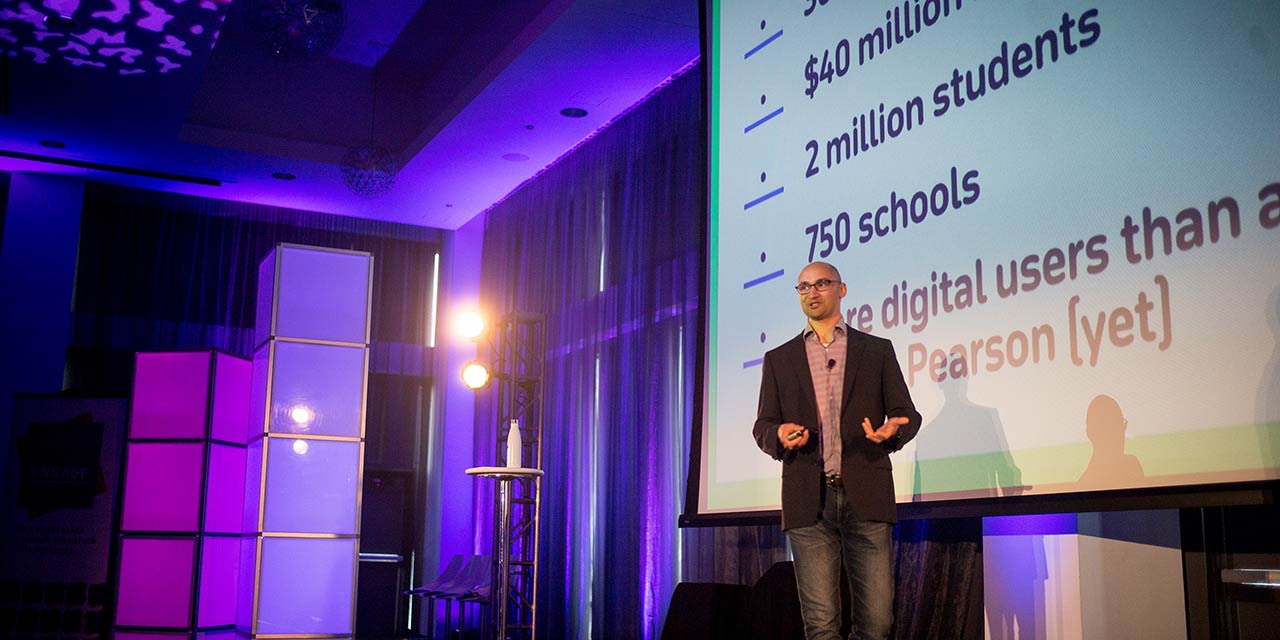At the Engage 2017 conference in Chicago, guests enjoyed an array of sessions that touched on topics ranging from active learning to the future of textbooks. Here are some of the most important things we learned about innovation and storytelling.
-
-
Higher education can learn from Silicon Valley
-
Universities that have bureaucratic and slow-moving decision-making processes are failing to innovate—making it harder to introduce modern teaching techniques.
In his keynote speech, Top Hat CEO Mike Silagadze said that the college industry would do well to adopt a Silicon Valley mentality: “Companies like AirBnB and Lyft put power back in the hands of the individual creator and took it away from the middle-men. And our mission at Top Hat is to do that in the education space.”
Malgosia Green, Top Hat’s Chief Product Officer, also spoke about the need to change, “Educational institutions need to evolve by leveraging some of the amazing technologies available to us. if not, they’re doing a disservice to students.”
Audible gasps and "wows" as @tophat's Robbie Goldfarb shows us everything you can do with a living digital text #Engage2017 #digped #opened pic.twitter.com/CJLQqEtNzL
— Mike Di Gregorio (@mike_digs) October 2, 2017
https://www.instagram.com/p/BZv-i5Whv0D/?taken-by=tophat_inc
-
-
People remember stories, not facts.
-
Getting up in front of a class three times a week to deliver material you’ve been talking about for years can take a toll on anyone. How do you invigorate stale material and keep students engaged?
https://www.instagram.com/p/BZuJZiVBB8q/?taken-by=tophat_inc
Our keynote speaker on Day 1, Jonah Berger (pictured), marketing professor at the Wharton School of Business, explained that if educators view lectures as less of a mind dump of academic information, and more of a storytelling activity, students will be more likely to remember the information and talk about it post-class.
'People don't tell bedtime facts.' @j1berger #engage2017
— Luke Green, EdD (@LGreenSCTCC) October 1, 2017
“By understanding the underlying human behavior of why people share and remember things, we can be more effective as educators” #Engage2017 pic.twitter.com/L6qYYLrnTB
— Top Hat (@TopHat) October 1, 2017
-
-
The typical student’s needs have changed.
-
Not all students these days are aged 18–21, from middle- to upper-class backgrounds, living on or near campus. The modern student can be 17 or 70, might have English as a second language, and could be the first person in their family to attend a post-secondary institute. And as Jonah Berger pointed out in his keynote, audience is key.
In a session on distance learning, Laura Freberg, psychology professor at California Polytechnic State University, encouraged attendees to put themselves in their students’ shoes. She said that technology is wonderful as a way to open up access to education for all, but that they needed to understand that students require flexibility.
.@lfreberg says that distance learning is not just desktop learning—tech must be portable. "These students are on the move." #Engage2017 pic.twitter.com/5vj4OzWJZx
— Top Hat (@TopHat) October 1, 2017
“Whatever technology you decide to use in an online class, make sure your students can use it wherever they might be,” she said. That means making sure you can do things like allow for offline access.
Shaun Dakin, marketing professor at George Mason University, spoke about using technology to level the playing field. In his lectures, Dakin encourages those who may not feel comfortable speaking up to share their thoughts and opinions digitally.
In #Engage2017's diversity breakout @ShaunDakin says Top Hat helps students join discussions—even though 1/2 are non-native English speakers pic.twitter.com/ELAdUKIvo6
— Top Hat (@TopHat) October 2, 2017
-
You can change your style and reduce your workload too
Incorporating new techniques into class means jettisoning some old methods and material. And that’s normal, explains Michelle Newsome, chemistry instructor at Wright State. She told the audience: “If you’re really going to take on active learning, there’s some content you’re just going to have to give up. And you need to be okay with that.” It’s worth it, however—Newsome showed some good results:
Active learning gets results, says Michelle Newsome @WrightStateNews. @AmerChemSociety exam scores went up 20 PP in 5 semesters. #Engage2017 pic.twitter.com/4JDUE23L70
— Top Hat (@TopHat) October 2, 2017
John Redden, physiology professor at UConn, spoke at several talks including a session on finding time for professional development. He explained how he found a way to engage students while take the pressure off. “Students are our biggest untapped resource,” he said.
John Redden makes time for his own development by delegating to his students. Class members run many active learning sessions. #Engage2017 pic.twitter.com/e4HA93RvwS
— Top Hat (@TopHat) October 2, 2017
.@lfreberg on making time for professional development: "To find balance, you have to be willing to let go of perfection." #Engage2017 pic.twitter.com/J6kgKgdXZQ
— Top Hat (@TopHat) October 2, 2017
Of course, if you do save some time delegating, you could just it to sit back and make yourself some coffee.
https://www.instagram.com/p/BZuLXZwninN/


